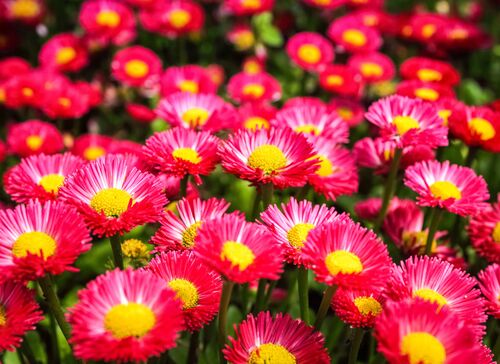Growing and Sowing Aster

Asters come in both annual and perennial varieties and can easily be grown from seed. Annual Asters can be sown early in spring and flower far into autumn. Once they have died off, they normally do not come back. However, they may self-sow. Asters can be used as cut flowers and are available in many different colours.
Sowing and growing Asters
Asters belong to the composite family and are available in several colours. Depending on the variety, the plants grow 50 to 80 cm tall and fit well in any size of garden. In small gardens at the back of the border, in larger gardens in the middle of the border. Asters have a long blooming period.
Sowing asters from seeds
Sowing asters indoors can be done as early as early spring, around March or April after which they can be planted outside in May. Sowing outside can be done from about April to June. Soaking the seeds overnight in lukewarm water can speed up the germination process. Cover the seeds with a thin layer of soil and keep it moist, but not too wet. When the seedlings are about 5 cm high, they can be transplanted.
Position and soil of aster flowers
Asters prefer a sunny spot in the garden and makes no specific demands on the soil, except that it should be well-drained.
How to care for your aster plants
Asters need little care as long as they are in the sun. Water regularly remove faded flowers and remove weeds around the plants.
Are asters bee- and/or butterfly-friendly?
Asters are insect-friendly and attract various beneficial insects such as bees, butterflies and other pollinators. Asters provide nectar and pollen, which is essential for these insects, especially in late summer and autumn when other flowers are less available.
Asters in the vegetable garden
Asters can be a great addition to your vegetable garden. Besides looking beautiful, they also have a number of benefits. They attract pollinators, which also benefits the pollination of vegetable plants and fruit trees. An additional benefit is that the ‘good bugs’ often repel the harmful insects. Sowing asters among other crops also increases biodiversity in your garden.
Are Asters edible and/or medicinal?
Most species of asters are edible and are used in salads and as a garnish. The flowers and leaves of edible asters have a mild, slightly sweet taste. It's important to make sure you have the right species, as not all asters are edible.
Some species of asters are claimed to have medicinal properties. They are often used for their anti-inflammatory effects and could help with relief from coughs or skin problems. The flowers can be eaten raw or made into tea. The leaf and root are also edible, for example cooked, and are said to have a laxative effect and help against headaches.
Please note, we at Dutch Garden Seeds do not give medical advice. Always ask a professional if and how the plant can be used medicinally.
Aster seeds in our collection
We have different types of annual asters in our range. There is a clear description for each species.
Tips for Sowing Asters
- Remove the dead flowers regularly. This will make the plant bloom longer.
- Do not sow asters in the same place for 2 years in a row to prevent wilting diseases.



